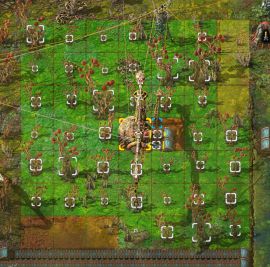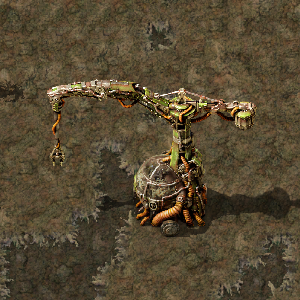Agricultural tower
| Agricultural tower |
|
Recipe |
|||||||||||||
| ++++ → | |||||||||||||
|
Total raw |
|||||||||||||
| +++++ | |||||||||||||
|
Map color |
|||||||||||||
|
Health |
|
||||||||||||
|
Resistances |
Fire: 0/100% |
||||||||||||
|
Stack size |
20 |
||||||||||||
|
20 (1 stack) |
|||||||||||||
|
Dimensions |
3×3 |
||||||||||||
|
Energy consumption |
100 kW (electric) |
||||||||||||
|
Mining time |
0.2 |
||||||||||||
|
Prototype type |
|||||||||||||
|
Internal name |
agricultural-tower |
||||||||||||
|
Required technologies |
|||||||||||||
|
Produced by |
|||||||||||||
| This article is a stub, and not comprehensive. |
|---|
| You can help this wiki by expanding it. |
![]() Space Age expansion exclusive feature.
Space Age expansion exclusive feature.
The agricultural tower is a machine unlocked on Gleba. It automatically harvests and re-plants trees in its range, provided that it is supplied with seeds obtained via fruit processing, and the soils near it support the kinds of seeds it is loaded with.
The agricultural tower can plant yumako seeds, jellynut seeds, or tree seeds. The agricultural tower's working area is broken up into 3×3 tile sectors - if one of these sectors is completely filled with a viable soil type, and the agricultural tower has a matching seed in its inventory (artificial yumako soil![]() or overgrowth yumako soil
or overgrowth yumako soil![]() for yumako seeds, and artificial jellynut soil
for yumako seeds, and artificial jellynut soil![]() or overgrowth jellynut soil
or overgrowth jellynut soil![]() for jellynut seeds), then it will automatically plant the seed in that area. Hovering the cursor over an agricultural tower reveals its range, broken up into the 3×3 sectors; each sector will be color coded, with a green sector representing farmable land, a yellow sector representing areas that could have the farmable landfills placed there, and a red sector representing an area that cannot be farmed. The yellow indicator does not make a distinction between overgrowth and regular soil, so it is possible that a tile may appear to be farmable before the player can actually farm it. Note that a red area may have some farmable areas within it, the colour of the 3x3 sector is decided as a whole.
for jellynut seeds), then it will automatically plant the seed in that area. Hovering the cursor over an agricultural tower reveals its range, broken up into the 3×3 sectors; each sector will be color coded, with a green sector representing farmable land, a yellow sector representing areas that could have the farmable landfills placed there, and a red sector representing an area that cannot be farmed. The yellow indicator does not make a distinction between overgrowth and regular soil, so it is possible that a tile may appear to be farmable before the player can actually farm it. Note that a red area may have some farmable areas within it, the colour of the 3x3 sector is decided as a whole.

The agricultural tower will plant seeds and wait to harvest them until they have reached maturity. For yumako trees and jellystem trees, this is 5 minutes. For Nauvis trees planted with tree seeds, this takes 10 minutes.
Tips
Unlike most other methods of resource gathering in the game, agricultural towers do not benefit from mining productivity research, and they have no module slots. Each processed fruit has a 2% chance to return its respective seed, so the expected number of seeds that each tree produces is one - the same number of seeds that was used to produce the tree. Initially, this may restrict efforts to grow plantations, especially if fruits are allowed to spoil before being processed, which can actually result in the effective stock of trees and seeds diminishing. However, fruit processing does benefit from productivity - either via productivity modules or via the 50% inbuilt productivity of the biochamber![]() . Using just a biochamber with no extra productivity modules takes the expected seeds each tree returns from 1 to 1.5.
. Using just a biochamber with no extra productivity modules takes the expected seeds each tree returns from 1 to 1.5.
Note that this is only an expectation - there is no underlying mechanic that guarantee 50 fruits will return any number of seeds. It is entirely possible that one might process all 50 fruits harvested from a single tree, or even multiple trees, and obtain no seeds in return.
Agricultural towers may be activated or deactivated via the circuit network. This can be useful to avoid letting excess fruit back up, as they may eventually spoil and be wasted - and even if it does not, the extra time spent waiting to be processed decreases the freshness![]() of the item, which in turn may decrease the freshness of recipes that consume this item. It's worth mentioning that agricultural towers will collect fruit until their inventory is full, even if inserters aren't removing the fruits, and therefore it's inadvisable to control fruit production via inserters, lest the fruit turns into spoilage
of the item, which in turn may decrease the freshness of recipes that consume this item. It's worth mentioning that agricultural towers will collect fruit until their inventory is full, even if inserters aren't removing the fruits, and therefore it's inadvisable to control fruit production via inserters, lest the fruit turns into spoilage![]() while still inside the agricultural tower.
while still inside the agricultural tower.
Because agricultural towers generate 50 fruit per tree, one might want to use stack inserters for their output. However, since 50 is not evenly divisible by 16, this can lead to stack inserters holding onto the last bundle of items until the next tree is harvested. If you attempt to deactivate towers periodically to control their output, this can lead to fruit losing some spoil time sitting in the inserter's hand.
This can be avoided however. If you wire the inserter to the tower, set the tower to "Read contents", and set the inserter to "set filter", this will cause the inserter's filters to reflect the contents of the tower. Output inserters cannot take from input slots for seeds, so that is not a problem. But if the tower is empty of fruits, then the fruit signal from the tower will no longer be active. If the stack inserter is still holding items, waiting for more, then the filter will no longer match the item in its hand. When this happens to a stack inserter, it will turn immediately to discard the held items, thus preventing the stack inserter from waiting for more items. This can lead to a belt that is not fully stacked (as 50 is not divisible by 4), but it still can pack belts very density.
